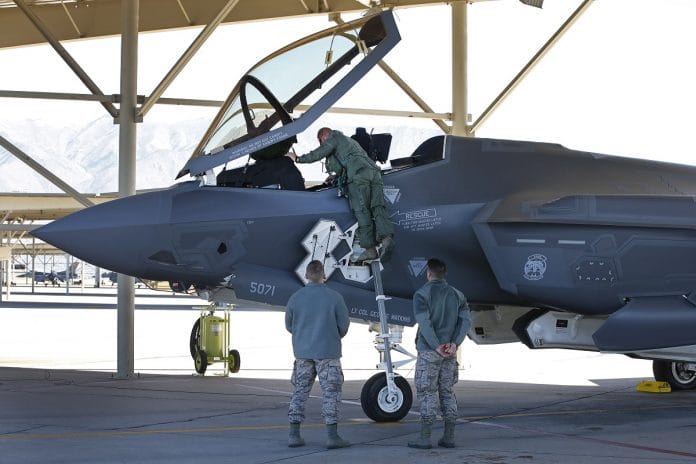Washington: Lockheed Martin Corp.’s F-35, the fighter jet already being flown by the U.S. and eight allies, remains marred by 871 software and hardware deficiencies that could undercut readiness, missions or maintenance, according to the Pentagon’s testing office.
The Defense Department’s costliest weapons system “continues to carry a large number of deficiencies, many of which were identified prior to” the development and demonstration phase, which ended in April 2018 with 941 flaws, Robert Behler, the director of operational testing, said in a new assessment obtained by Bloomberg News in advance of its publication.
Lockheed has delivered or is under contract for 970 aircraft of a potential 3,200 or more planes for the U.S. and other nations. The assessment outlining the seemingly intractable roster of flaws — it’s down only two from the 873 that Behler reported last year — provides the incoming Biden administration with a primer on the $398 billion F-35 program that retains strong backing in Congress and from overseas purchasers despite its problems.
Those include a stalled one-month simulation exercise required to certify the plane is combat-ready against the toughest Russian or Chinese threats and thus ready for a decision on full-rate production.
In October, the F-35 program will mark 20 years since Bethesda, Maryland-based Lockheed beat rival Boeing Co. in the contest to build the next-generation U.S. fighter.
Laura Seal, a spokesperson for the Defense Department’s F-35 program office, declined to comment until Behler’s report is released officially.
Aside from the technical flaws, the F-35 program faces a $10 billion shortfall in the Pentagon’s planned budget for 2021 through 2025. The Trump administration’s final budget blueprint calls for requesting $78 billion for research and development, jet procurement, operations and maintenance and military construction. But the Pentagon’s independent cost analysis unit estimates $88 billion will be needed, according to a June 2020 analysis.
Also read: F-16 never stood a chance to be in IAF fleet. Lockheed Martin messed it up so much
Upgrade schedule
The F-35 program is undergoing a “Block 4” upgrade costing at least $12.1 billion that’s intended to correct past deficiencies and introduce new capabilities in six-month increments through 2026 to keep up with current threats. The plan includes retrofitting some planes already built and in use by militaries from the U.S. and the U.K. to Japan.
Even with this focused effort, “the overall number of open deficiencies has not changed significantly since” early 2018, Behler wrote, “due to ongoing problems with initial software quality” in Block 4 and “limited lab and flight test capability, resulting in a high rate of problem discoveries” in testing and in the field.
The Block 4 process “is not working,” Behler wrote. “It is causing significant delays to planned schedules and results in poor software quality, containing deficiencies.” Software changes “intended to introduce new capabilities or fix deficiencies often introduced stability problems.”
Only 10 of the 871 unresolved deficiencies cited by Boehler involve potentially serious “Category 1” issues, defined as critical deficiencies that could jeopardize pilot or aircraft safety or degrade mission effectiveness. That’s compared with 102 such problems among the 941 cases cited in 2018.
Lockheed said in a statement that none of the 10 current deficiencies are “1A” problems that could affect pilot or aircraft safety but instead are in “Category 1B,” which the program office defines as representing “a critical impact on mission readiness,” training or maintenance.
“Though we have not seen the report, we track all F-35 deficiency reports,” Lockheed spokesman Brett Ashworth said in a statement. He said about 70% of the 871 pending items “are categorized as low priority or are with the F-35 Joint Program Office for resolution.”
Of the 10 pending “mission impacts” deficiency reports, nine have “closure resolution plans, with seven already delivered to the government awaiting action,” and the others currently being reviewed.
A defense official who’s seen the Behler assessment said many of the deficiencies will be resolved with production line changes and software updates. Although deficiencies must be documented for contractual and reporting purposes, the official said, depending on their severity they might not be rapidly resolved. The size, scope and resolution status are being evaluated as part of the ongoing negotiations for a 15th production contract, the official said.
Among other findings, the testing office’s report said that although the F-35 is showing increased reliability, it’s still taking maintenance personnel too much time to repair aircraft and that cybersecurity vulnerabilities identified during earlier testing “have not been resolved.”- Bloomberg
Also read: Why selling F-35 fighter jets to UAE complicates US ties with Israel






